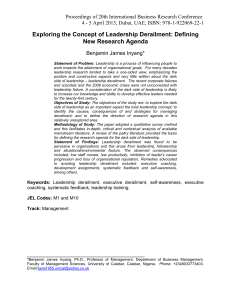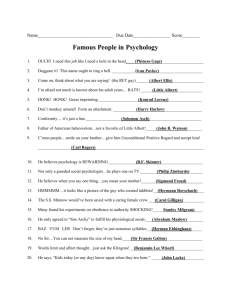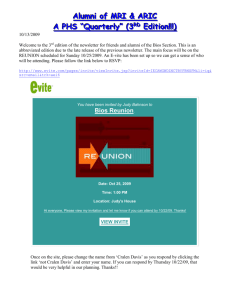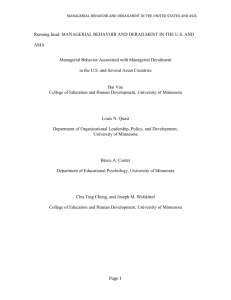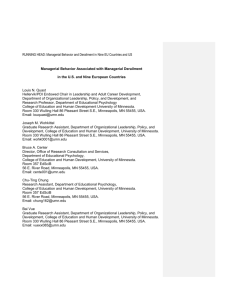Preventing Executive/Management Career Derailment –
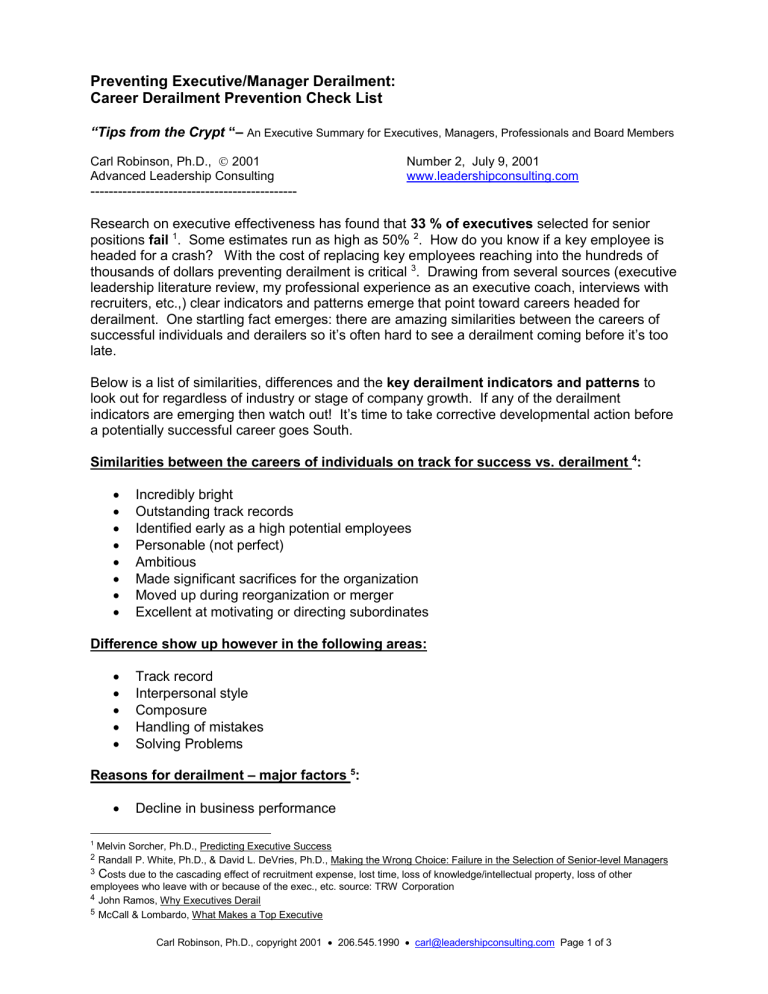
Preventing Executive/Manager Derailment:
Career Derailment Prevention Check List
“Tips from the Crypt “–
An Executive Summary for Executives, Managers, Professionals and Board Members
Carl Robinson, Ph.D.,
2001
Advanced Leadership Consulting
---------------------------------------------
Number 2, July 9, 2001 www.leadershipconsulting.com
Research on executive effectiveness has found that 33 % of executives selected for senior positions fail 1 . Some estimates run as high as 50% 2 . How do you know if a key employee is headed for a crash? With the cost of replacing key employees reaching into the hundreds of thousands of dollars preventing derailment is critical 3 . Drawing from several sources (executive leadership literature review, my professional experience as an executive coach, interviews with recruiters, etc.,) clear indicators and patterns emerge that point toward careers headed for derailment. One startling fact emerges: there are amazing similarities between the careers of successful individuals and derailers so it’s often hard to see a derailment coming before it’s too late.
Below is a list of similarities, differences and the key derailment indicators and patterns to look out for regardless of industry or stage of company growth. If any of the derailment indicators are emerging then watch out! It’s time to take corrective developmental action before a potentially successful career goes South.
Similarities between the careers of individuals on track for success vs. derailment 4 :
Incredibly bright
Outstanding track records
Identified early as a high potential employees
Personable (not perfect)
Ambitious
Made significant sacrifices for the organization
Moved up during reorganization or merger
Excellent at motivating or directing subordinates
Difference show up however in the following areas:
Track record
Interpersonal style
Composure
Handling of mistakes
Solving Problems
Reasons for derailment – major factors 5 :
Decline in business performance
1 Melvin Sorcher, Ph.D., Predicting Executive Success
2
Randall P. White, Ph.D., & David L. DeVries, Ph.D., Making the Wrong Choice: Failure in the Selection of Senior-level Managers
3 C osts due to the cascading effect of recruitment expense, lost time, loss of knowledge/intellectual property, loss of other employees who leave with or because of the exec., etc. source: TRW Corporation
4 John Ramos, Why Executives Derail
5
McCall & Lombardo, What Makes a Top Executive
Carl Robinson, Ph.D., copyright 2001
206.545.1990
carl@leadershipconsulting.com
Page 1 of 3
Insensitive, abrasive, intimidating style
Poor criticism tolerance
Poor frustration tolerance
Cold, aloof, arrogant
Betrayed trust
Over managing – failing to delegate, build team
Overly ambitious
Poor staffing ability
Unable to think strategically
Unable to adapt to boss, culture of company
Conflict adverse
Poor interpersonal communication
Overly dependent on others to advocate for them
Specific skill deficiencies
How these flaws are usually discovered – a few examples:
Loss of a boss who covered the weakness
Inept handling of a performance problem of a subordinate
Clash with boss or other employees
Trail of little problems that reach a critical mass
Trail of bruised people
Strengths became weaknesses – did not adapt to changing business conditions
Success went to his/her head and became arrogant
Key take a-ways and applications:
The research on executive success is clear - successful executives are developed not hatched full grown. Wayne Calloway the late CEO of PepsiCo said,
“I’ll bet most of the companies that are in life-or-death battles got into that kind of trouble because they didn’t pay enough attention to developing their leaders.” Successful executive are active learners. They make mistakes but learn from their mistakes. So, run through the list of derailment factors on your key managers and if you see any red flags (similarities)
– take corrective developmental action to prevent derailment and the costly financial and personal consequences.
The following guidelines for behavioral change can help people change
–
Assess > Plan > Take Action > Re-Assess >:
Clearly identify the desired changes – identify the problem behavior(s) clearly?
Determine who can provide meaningful feedback
Collect feedback
Analyze results
Develop an action plan
Have the “candidate” respond to key stakeholder
Develop an ongoing follow-up and re-assessment process
Review results
Do it again until the new behavior is learned
Let me know your reactions or questions and I will respond to them in the next newsletter or privately.
Carl Robinson, Ph.D., copyright 2001
206.545.1990
carl@leadershipconsulting.com
Page 2 of 3
Regards,
Carl
Carl Robinson, Ph.D.
Advanced Leadership Consulting
927 N. Northlake Way, Suite 220
Seattle, WA 98103
T: 206.545.1990 E: carl@leadershipconsulting.com
http:// www.leadershipconsulting.com
About this email: This executive summary is sent only to people who have been on my mailing list. If you prefer not to receive it (I will only send it when I have something from my research that I think is important to convey
– not more than once per month), please write “don’t bug me” in the subject line and return to me.
If a “friend” or associate forwarded this to you and you want to be on my list, please let me know, otherwise you probably won’t receive it again. I promise never to give out your address, that is why I only send this by Blind Copy
(BCC). Lastly, please send me feedback, questions, ideas, etc.
2001, Carl Robinson, Ph.D. Feel free to forward this summary to any interested party but, it must include all identifying and copyright information. Permission to use this summary or portions of it in other publications is required by the author in advance.
Bio:
Carl Robinson, Ph.D., has been in the business of helping people unlock and develop their hidden potential for over
20 years. Dr. Robinson uses researched-based motivational and performance enhancement technologies to help individuals and teams make enduring changes to help them achieve th eir individual and organization’s goals.
He is a specialist in leadership and executive development in both team and individual settings, and his projects have included:
Executive development
Derailment turnarounds and prevention
Career assessment and development
Executive assessment and recruitment advice
Leadership development strategy and implementation
Executive team development
Resolution of damaging relationship Improving the effectiveness of executive team/board relationships.
Pre-promotional and succession planning evaluations and development
Advising Board members and VCs regarding executive selection and development for portfolio companies
His clients come from a variety of industries and organizations but primarily centered on companies who offer intellectually based products in highly competitive volatile markets with people who are intelligent, creative and impatient.
Carl is currently writing a book on the personality differences between startup and mainstream executives to help boards and executive teams chose the right executive for the right stage of growth in companies. Bigby/Havis, the developers and distributors of the ASSESS Personality Survey is providing data analysis for this project.
He has a Bachelor’s degree in Human Relations and Organizational Behavior from the University of San Francisco and, a Masters in Counseling Psychology from Vermont College and a Ph.D. in Counseling Psychology from the
California Institute of Integral Studies. Counseling psychology is the branch of psychology that is concerned with the enhancement of human performance and the quality of life. His dissertation research investigated factors that influence creative thinking.
Carl is a member of the Consulting Psychology division of the American Psychological Association and a member of the Northwest Venture Group. He speaks nationally on a variety of topics related to organizational and leadership development. Recently, he was a panelist at the March, 2001, MIT Enterprise Forum – “Tales from the Crypt:
Board/CEO Interactions. In August 2001, he will be speaking at the Young Entrepreneurs Organization (YEO) international meeting in Seattle. The Puget Sound Business Journal recently published Dr. Robinson’s article –
“Leading Effectively: Leadership Can Be Taught, But Commitment Needed.”
Carl Robinson, Ph.D., copyright 2001
206.545.1990
carl@leadershipconsulting.com
Page 3 of 3

